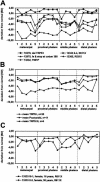Genotypic and phenotypic spectrum in tricho-rhino-phalangeal syndrome types I and III
- PMID: 11112658
- PMCID: PMC1234936
- DOI: 10.1086/316926
Genotypic and phenotypic spectrum in tricho-rhino-phalangeal syndrome types I and III
Abstract
Tricho-rhino-phalangeal syndrome (TRPS) is characterized by craniofacial and skeletal abnormalities. Three subtypes have been described: TRPS I, caused by mutations in the TRPS1 gene on chromosome 8; TRPS II, a microdeletion syndrome affecting the TRPS1 and EXT1 genes; and TRPS III, a form with severe brachydactyly, due to short metacarpals, and severe short stature, but without exostoses. To investigate whether TRPS III is caused by TRPS1 mutations and to establish a genotype-phenotype correlation in TRPS, we performed extensive mutation analysis and evaluated the height and degree of brachydactyly in patients with TRPS I or TRPS III. We found 35 different mutations in 44 of 51 unrelated patients. The detection rate (86%) indicates that TRPS1 is the major locus for TRPS I and TRPS III. We did not find any mutation in the parents of sporadic patients or in apparently healthy relatives of familial patients, indicating complete penetrance of TRPS1 mutations. Evaluation of skeletal abnormalities of patients with TRPS1 mutations revealed a wide clinical spectrum. The phenotype was variable in unrelated, age- and sex-matched patients with identical mutations, as well as in families. Four of the five missense mutations alter the GATA DNA-binding zinc finger, and six of the seven unrelated patients with these mutations may be classified as having TRPS III. Our data indicate that TRPS III is at the severe end of the TRPS spectrum and that it is most often caused by a specific class of mutations in the TRPS1 gene.
Figures




Similar articles
-
Phenotype and genotype in 103 patients with tricho-rhino-phalangeal syndrome.Eur J Med Genet. 2015 May;58(5):279-92. doi: 10.1016/j.ejmg.2015.03.002. Epub 2015 Mar 16. Eur J Med Genet. 2015. PMID: 25792522
-
Deletion of the GATA domain of TRPS1 causes an absence of facial hair and provides new insights into the bone disorder in inherited tricho-rhino-phalangeal syndromes.Mol Cell Biol. 2002 Dec;22(24):8592-600. doi: 10.1128/MCB.22.24.8592-8600.2002. Mol Cell Biol. 2002. PMID: 12446778 Free PMC article.
-
Analysis of novel and recurrent mutations responsible for the tricho-rhino-phalangeal syndromes.J Hum Genet. 2002;47(3):103-6. doi: 10.1007/s100380200010. J Hum Genet. 2002. PMID: 11950061
-
The function of TRPS1 in the development and differentiation of bone, kidney, and hair follicles.Histol Histopathol. 2011 Jul;26(7):915-21. doi: 10.14670/HH-26.915. Histol Histopathol. 2011. PMID: 21630221 Review.
-
The effect of growth hormone treatment in a child with tricho-rhino-phalangeal syndrome: A case report and review of the literature.Eur J Med Genet. 2020 Apr;63(4):103830. doi: 10.1016/j.ejmg.2019.103830. Epub 2019 Dec 26. Eur J Med Genet. 2020. PMID: 31884116 Review.
Cited by
-
Trichorhinophalangeal Syndrome Type I: A Patient with Two Novel and Different Mutations in the TRPS1 Gene.Case Rep Genet. 2013;2013:748057. doi: 10.1155/2013/748057. Epub 2013 Apr 17. Case Rep Genet. 2013. PMID: 23691375 Free PMC article.
-
Rubinstein-Taybi syndrome: Clinical profile of 11 patients and review of literature.Indian J Hum Genet. 2012 May;18(2):161-6. doi: 10.4103/0971-6866.100751. Indian J Hum Genet. 2012. PMID: 23162289 Free PMC article.
-
Non-ossifying fibroma with a pathologic fracture in a 12-year-old girl with tricho-rhino-phalangeal syndrome: a case report.BMC Med Genet. 2018 Dec 12;19(1):211. doi: 10.1186/s12881-018-0732-4. BMC Med Genet. 2018. PMID: 30541476 Free PMC article.
-
Dysmorphic Short Stature: Radiological Diagnosis of Trichorhinophalangeal Syndrome.Case Rep Pediatr. 2018 Nov 21;2018:5189062. doi: 10.1155/2018/5189062. eCollection 2018. Case Rep Pediatr. 2018. PMID: 30584486 Free PMC article.
-
Novel Frameshift Mutation in TRPS1 in a Ukrainian Patient with Trichorhinophalangeal Syndrome Type I.Int J Trichology. 2013 Jul;5(3):159-60. doi: 10.4103/0974-7753.125620. Int J Trichology. 2013. PMID: 24574699 Free PMC article.
References
Electronic-Database Information
-
- GenBank, http://www.ncbi.nlm.nih.gov/index.html (for TRPS1 genomic sequence [accession number AF178030] and for TRPS1 cDNA sequence [accession number AF183810])
-
- Online Mendelian Inheritance in Man (OMIM), http://www.ncbi.nlm.nih.gov/Omim (for TRPS I [190350], TRPS II [150230], TRPS III [190351], TRPS1 [604386])
-
- Tricho-Rhino-Phalangeal Syndrome Project, http://www.uni-essen.de/~thg020/TRPS1/Table3.html (for sequences of primers used for mutation analysis and generation of the TRPS1 exon 6 hybridization probe)
References
-
- Brandt CA, Lüdecke H-J, Hindkjær J, Strømkjær H, Pinkel D, Herlin T, Bolund L, Friedrich U (1997) A de novo complex t(7;13;8) translocation with a deletion in the TRPS gene region. Hum Genet 100:334–338 - PubMed
-
- Felman AH, Frias JL (1977) The trichorhinophalangeal syndrome: study of 16 patients in one family. Am J Roentgenol 129:631–638 - PubMed
-
- Frischmeyer PA, Dietz HC (1999) Nonsense-mediated mRNA decay in health and disease. Hum Mol Genet 8:1893–1900 - PubMed
-
- Garn SM, Hertzog KP, Poznanski AK, Nagy JM (1972) Metacarpophalangeal length in the evaluation of skeletal malformation. Radiology 105:375–381 - PubMed
-
- Giedion A (1968) Zapfenepiphysen. Naturgeschichte und diagnostische Bedeutung einer Störung des enchondralen Wachstums. In: Glaumer R, Rüttiman A, Thurn P, Vogler E (eds) Ergebnisse der medizinischen Radiologie. Georg Thieme Verlag, Stuttgart, pp 59–124
Publication types
MeSH terms
Substances
Associated data
- Actions
- Actions
LinkOut - more resources
Full Text Sources
Other Literature Sources
Molecular Biology Databases
Miscellaneous

